Welcome to our extensive guide on using coffee grounds for plants indoors to boost their vitality and beauty. As any plant lover knows, the secret to vibrant, thriving indoor greenery often lies in the little things – the tweaks and tips that transform plant care from a chore into an art. One of these little-known secrets is the use of used grounds as a potent supplement for indoor plants.
Many people ponder the question: what indoor plants like coffee grounds? The answer is surprisingly broad. From flowering beauties like roses and azaleas to leafy fronds like ferns and philodendrons, a wide variety of plants can flourish when introduced to used grounds. The benefits of used grounds are manifold, from improving soil structure to deterring pests.
In our comprehensive guide titled “Coffee Grounds for Plants Indoor: Boosting Your Greenery”, we’ll unravel the science behind why used grounds can be so beneficial for indoor plants, how to use them correctly, and which plants appreciate this boost the most. Stay with us as we dive into this exciting topic that combines your morning ritual with your love for indoor gardening. Whether you’re a seasoned indoor gardener or a beginner green thumb, there’s a lot to learn and experiment with when it comes to harnessing the power of used grounds for your indoor plants.
Coffee Grounds for Plants Indoor: Key Takeaway
- Versatile Nutrient Source: Coffee grounds are rich in essential nutrients like nitrogen, calcium, and magnesium, making them versatile and effective soil amendments for indoor plants.
- Ideal for Acid-Loving Plants: Acid-loving plants, such as azaleas, hydrangeas, and gardenias, particularly benefit from the slightly acidic nature of used grounds.
- Effective Pest Control: Used grounds can also act as a natural pest deterrent, protecting your indoor plants from common pests like fungus gnats and slugs.
- Various Other Uses: Beyond plant nutrition, used grounds can be utilized in several other aspects of indoor gardening, including composting, worm farming, and odor neutralization.
Understanding the Benefits of Coffee Grounds
In the world of indoor plant care, used grounds are often touted as a secret weapon for healthier, more robust greenery. But what exactly are the benefits of using coffee grounds for plants indoors? How do they help your plants flourish? Below, we delve into the nutritional composition of used grounds, their impact on soil structure, and their potential as a natural pesticide.
Nutritional Composition of Coffee Grounds

The first step to understanding the benefits of coffee grounds is recognizing their rich nutritional composition. Coffee grounds are high in nitrogen, a vital nutrient for plant growth, and they also contain respectable amounts of potassium and phosphorus, both of which are essential for plant health. Additionally, they have traces of micronutrients like calcium, magnesium, and copper. These nutrients are released slowly, which means they provide a sustained feed for your indoor plants. (1)
While all plants can benefit from these nutrients to some degree, certain indoor plants like coffee grounds more due to their specific nutrient needs. For instance, plants that require acidic soil, such as azaleas, hydrangeas, and rhododendrons, often thrive when supplemented with used grounds. (2)
Enhancing Soil Structure with Coffee Grounds
Beyond providing nutrients, coffee grounds can also improve the physical structure of your potting soil. Used grounds are organic matter, and when mixed into your potting mix, they can help enhance its ability to retain moisture. This is especially beneficial for indoor plants that prefer consistently moist soil.

Moreover, the gritty texture of coffee grounds aids in improving soil aeration. This enhanced aeration allows plant roots to access oxygen more efficiently, crucial for healthy root development. In the indoor environment, where pots can restrict root growth and limit aeration, used grounds can make a significant difference.
Coffee Grounds as a Natural Pesticide
One of the lesser-known benefits of using coffee grounds for plants indoors is their potential as a natural pesticide. Coffee grounds have been found to deter certain pests like slugs and snails, which can be particularly troublesome for indoor plants. (3)
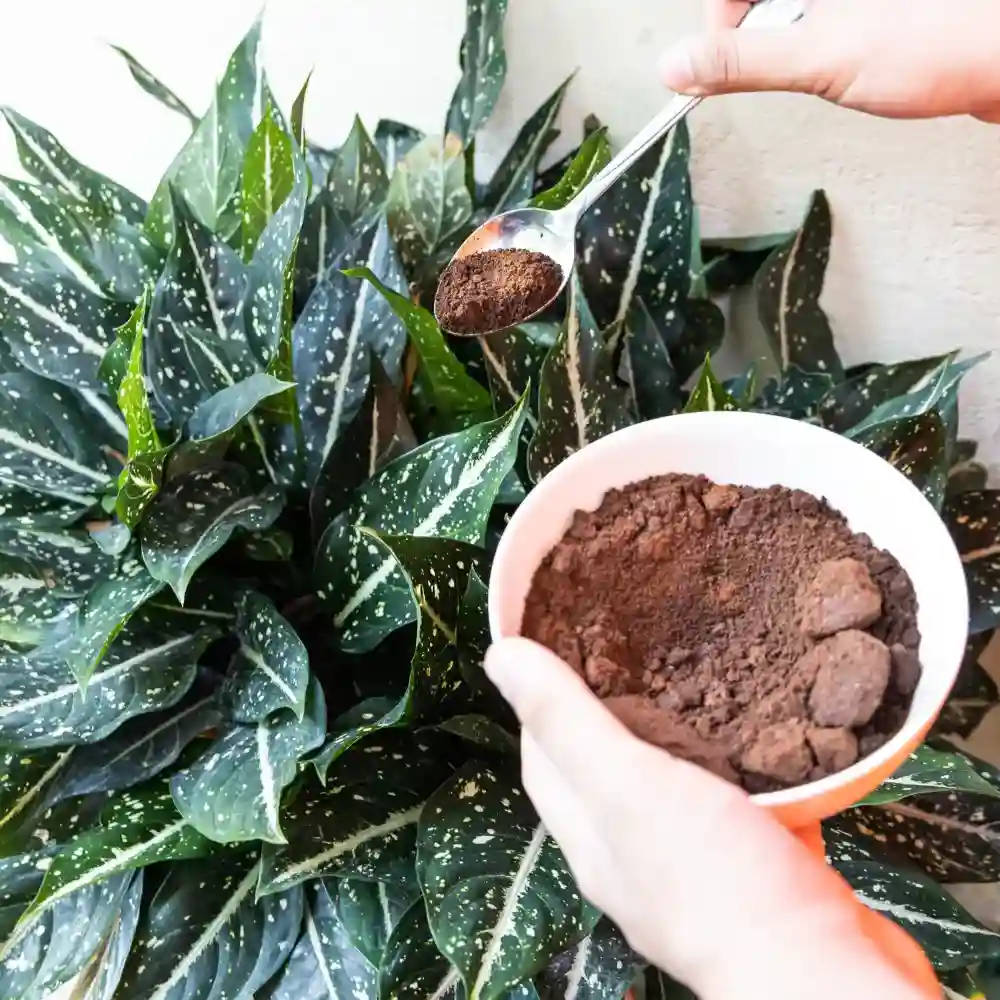
While the caffeine and diterpenes present in used grounds can be toxic to some insects, they are harmless to the plant itself. Therefore, using used grounds can be a safer, more natural alternative to chemical pesticides, particularly for indoor gardening where air circulation is limited, and chemical use should be minimized.
Understanding these benefits, it’s no surprise that more and more indoor gardeners are turning to used grounds as versatile addition to their plant care routines. So, next time you brew a pot of coffee, consider saving the grounds – your indoor plants may thank you for it.
How to Use Coffee Grounds for Indoor Plants
Knowing the benefits of coffee grounds is one thing, but understanding how to use them for your indoor plants is another. This section aims to guide you through the process of preparing and applying the grounds, along with advice on the correct application frequency.
Preparing Coffee Grounds for Plant Application
The first step in using coffee grounds for indoor plants is preparing them properly. Used grounds straight from your coffee maker can be too acidic and could harm your plants if used directly. It’s advisable to rinse the grounds thoroughly to remove any residual acidity.
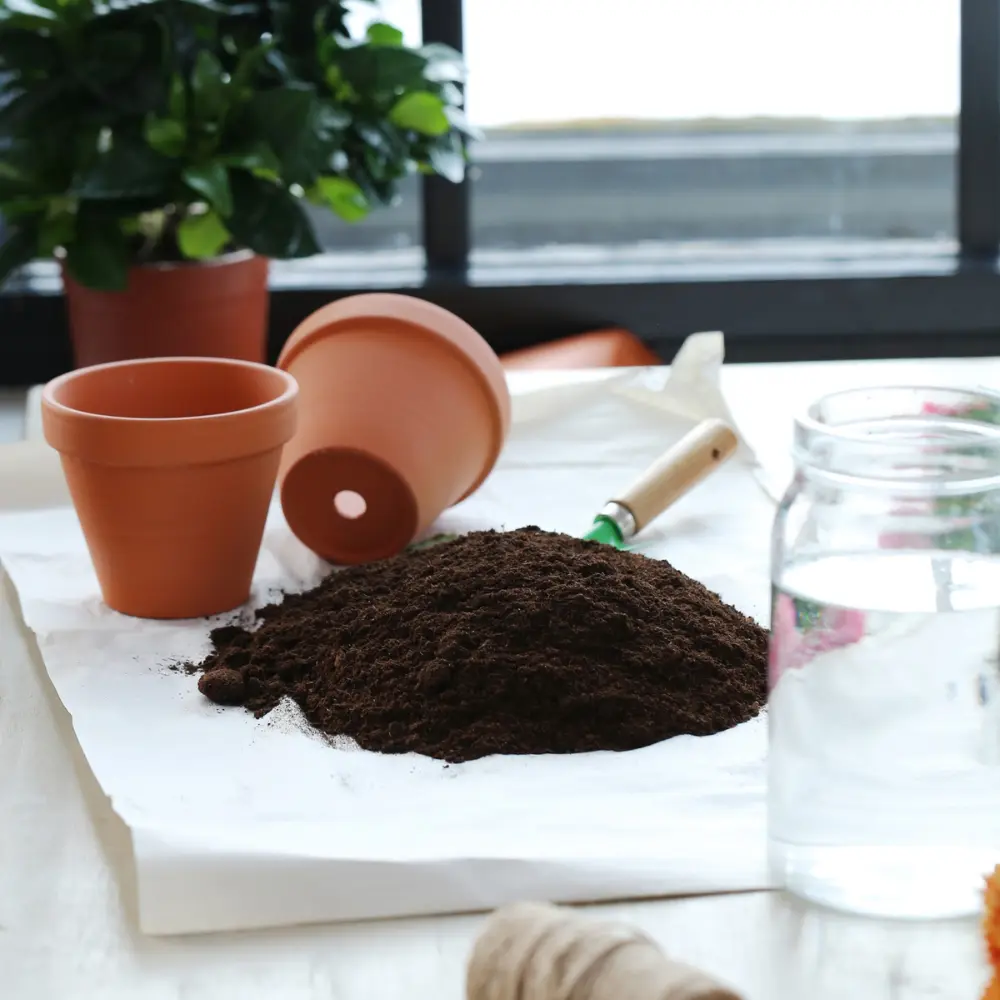
After rinsing, spread the grounds on a flat surface, preferably on a tray or a piece of newspaper, and let them dry completely. Drying helps to prevent the growth of mold, which could also be harmful to your plants. Once your grounds are clean and dry, they’re ready to be used.
Applying Used Grounds to Potted Plants
There are a couple of ways to apply the grounds to your indoor plants. The first method is to mix the grounds directly into the soil. Aim for a mixture that’s about one part grounds to four parts soil. This method works well for plants that benefit from the additional nitrogen that used grounds provide.
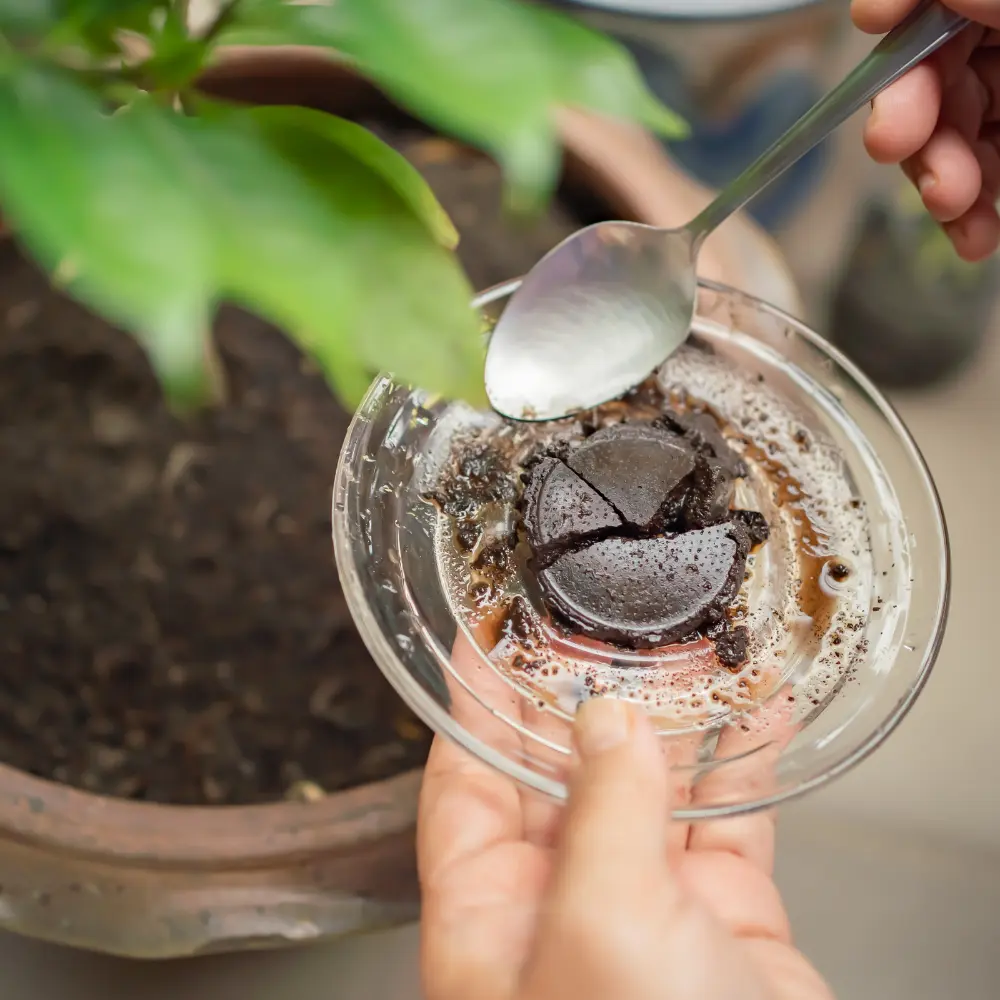
The second method is to use the grounds as mulch. Simply layer the grounds on top of the soil. This can help deter pests, conserve moisture, and slowly release nutrients into the soil.
It’s important to note that while used grounds can be beneficial, they should not replace your regular fertilizing regimen. Think of them more as a supplement that provides additional benefits.
Understanding the Correct Application Frequency
The frequency of applying used grounds can depend on the type of plant and its specific needs. As a general rule, it’s best to apply used grounds once a month for most indoor plants. This can be adjusted based on how well your plant appears to be responding; some plants may benefit from more frequent applications while others may prefer less.
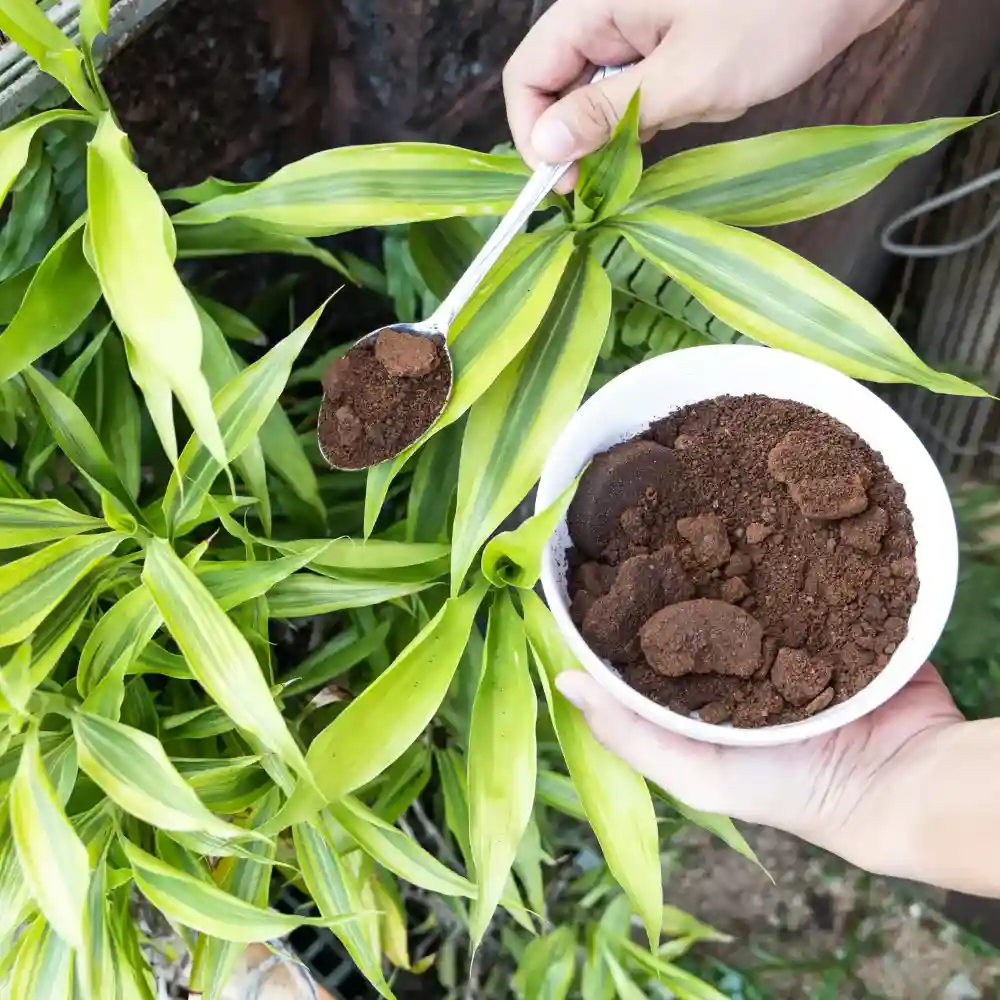
Remember, moderation is key. Too much of a good thing can be detrimental, and this applies to using coffee grounds for indoor plants. Overuse can lead to excessive moisture retention in the soil, potentially leading to root problems like rot and disease.
With these steps, you can confidently use the grounds to enhance the health and vigor of your indoor plants.
The Do’s and Don’ts of Using Coffee Grounds
Successfully using used grounds for plants indoors requires a nuanced understanding of when and how to use them. By learning the do’s and don’ts of using grounds, you can maximize their benefits and minimize any potential risks.
Indoor Plants That Thrive With Coffee Grounds
Certain indoor plants have shown a positive response to the application of coffee grounds, mostly due to their unique nutrient preferences and soil requirements. Let’s delve into a more detailed overview of these plants.
Acid-Loving Blooms
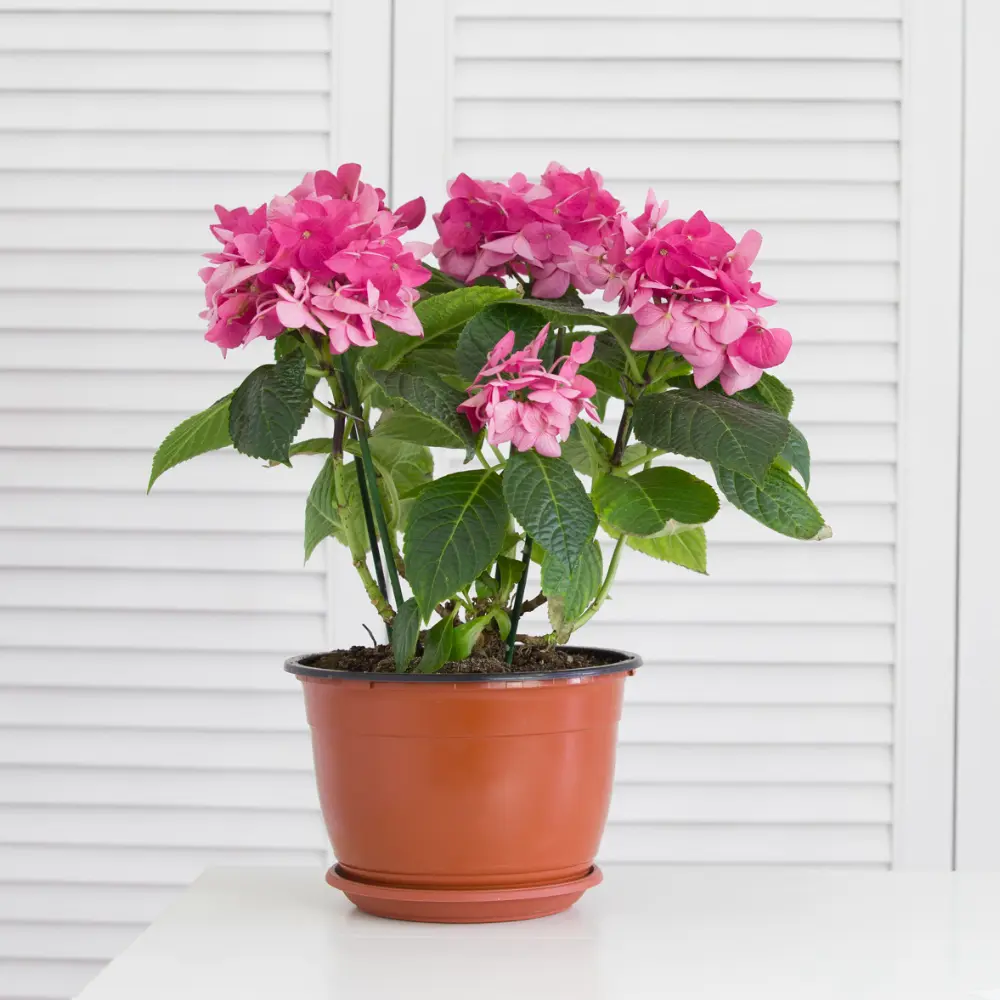
As discussed earlier, coffee grounds are slightly acidic in nature, making them a great supplement for indoor plants that prefer acidic soil.
- Azaleas: These stunning flowering plants flourish in slightly acidic soil. The nutrients in used grounds, especially nitrogen, can promote vibrant blooms and healthy growth.
- Hydrangeas: The pH level of the soil can influence the color of some hydrangea blooms. Used grounds can subtly acidify the soil, potentially leading to bluer flowers.
- Gardenias: With their beautiful, fragrant blooms, Gardenias are another acid-loving plant that can benefit from used grounds. The added nutrients can support bloom development and overall plant health.
Foliage Plants
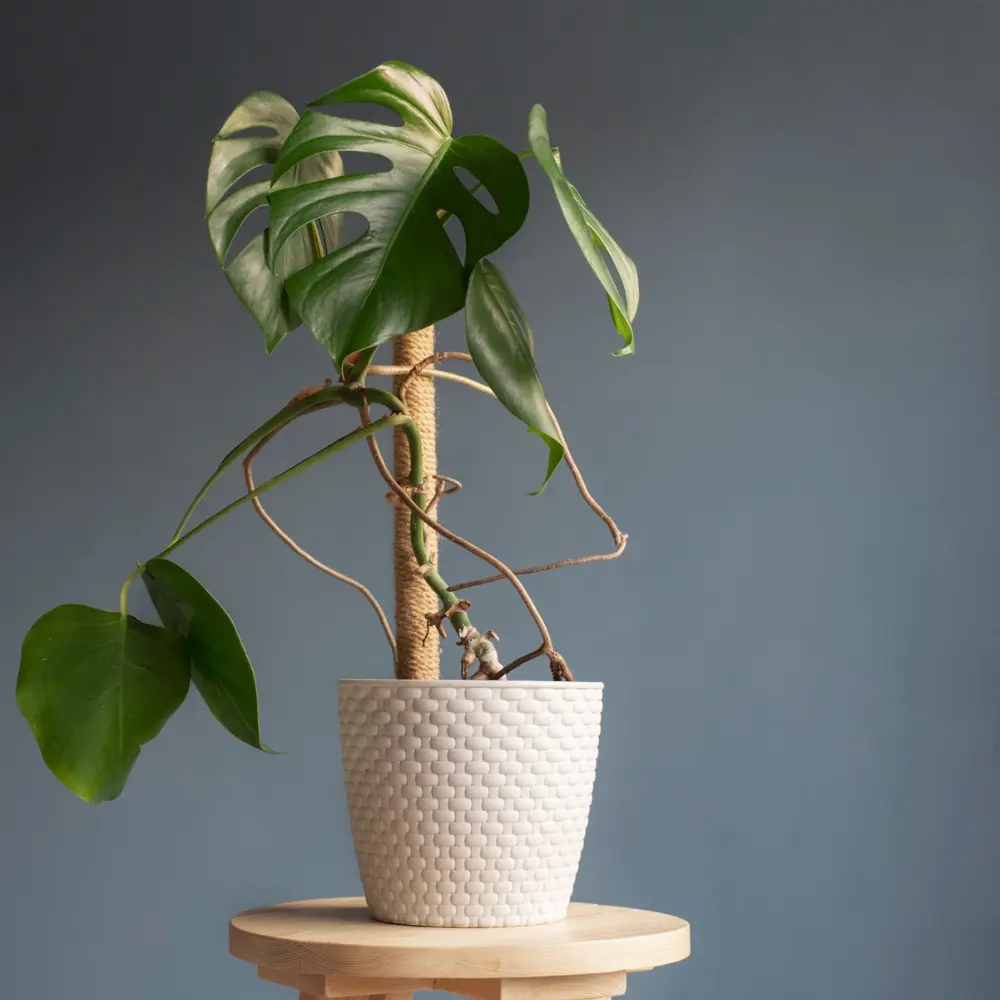
Plants known for their lush foliage also respond well to used grounds due to the high nitrogen content which supports leaf growth.
- Philodendrons: These popular houseplants appreciate the extra nitrogen in used grounds, promoting their vibrant green leaves and supporting overall growth.
- Monsteras: Known for their striking, large leaves, Monsteras can benefit from the slow release of nutrients from the grounds, particularly the high nitrogen content.
- Peace Lilies: Peace lilies, both a blooming and foliage plant, can enjoy the benefits of used grounds. The added nutrients can help keep their leaves lush while encouraging blooming.
Plants to Avoid

While many indoor plants appreciate used grounds, some do not, particularly those requiring well-draining soil and infrequent watering.
- Succulents: Most succulent varieties prefer a dry, well-draining soil environment. The moisture retention properties of used grounds can lead to overly wet soil, potentially causing root rot and other issues.
By understanding the unique requirements of each plant type, you can better determine whether used grounds can be a beneficial addition to your indoor plant care routine.
Potential Risks and How to Avoid Them
Despite the numerous benefits, improper use of coffee grounds for indoor plants can lead to problems. One of the primary risks is over-fertilization. Used grounds are rich in nitrogen, and while this nutrient is essential for plant growth, too much nitrogen can be detrimental. Symptoms of over-fertilization include yellowing leaves and stunted growth.

To avoid over-fertilization, it’s important to balance the use of coffee grounds with your regular fertilization routine. Used grounds should be used as a supplement, not a replacement for a comprehensive fertilizer. Also, moderation in application frequency can help prevent any negative effects.
Handling Mold Issues in Used Grounds
As mentioned before, coffee grounds, when not properly stored or used too heavily, can develop mold. This is due to their high moisture content and the dense way they clump together, creating an ideal environment for mold growth.

To prevent mold growth, it’s essential to dry the grounds completely before storing or applying them to your plants. Also, when applying to the soil, remember to mix them well or apply them thinly on the surface to avoid creating a dense, moisture-trapping layer.
Following these do’s and don’ts will ensure you’re leveraging the grounds effectively while protecting the health of your indoor plants. Remember, like all things in plant care, success with used grounds is a balance of understanding the needs of your plants and moderation in the application.
Other Uses of Coffee Grounds in Indoor Gardening
Beyond serving as a soil amendment for indoor plants, used grounds can play a variety of other roles in indoor gardening. They can be a valuable addition to your compost, a beneficial component in worm farming, and even work as an effective odor neutralizer.
Composting with Used Grounds
Composting is an effective method of recycling organic waste and creating nutrient-rich soil for your indoor plants and used grounds can be a significant contributor to this process. (4) Rich in nitrogen, they help create a balanced compost pile and accelerate the decomposition of other materials.

To use the grounds in your compost, add them to your compost bin or pile them along with other green waste (like vegetable peels or grass clippings) and brown waste (like leaves or newspaper). The used grounds will contribute nitrogen to the compost, helping to balance the carbon-rich brown materials and aiding in quicker decomposition.
Using Coffee Grounds for Worm Farming
If you’re an indoor gardener who practices vermiculture or worm farming, you’ll find coffee grounds to be a valuable resource. Worms are particularly fond of used grounds and their gritty nature can help with the worm’s digestion process.
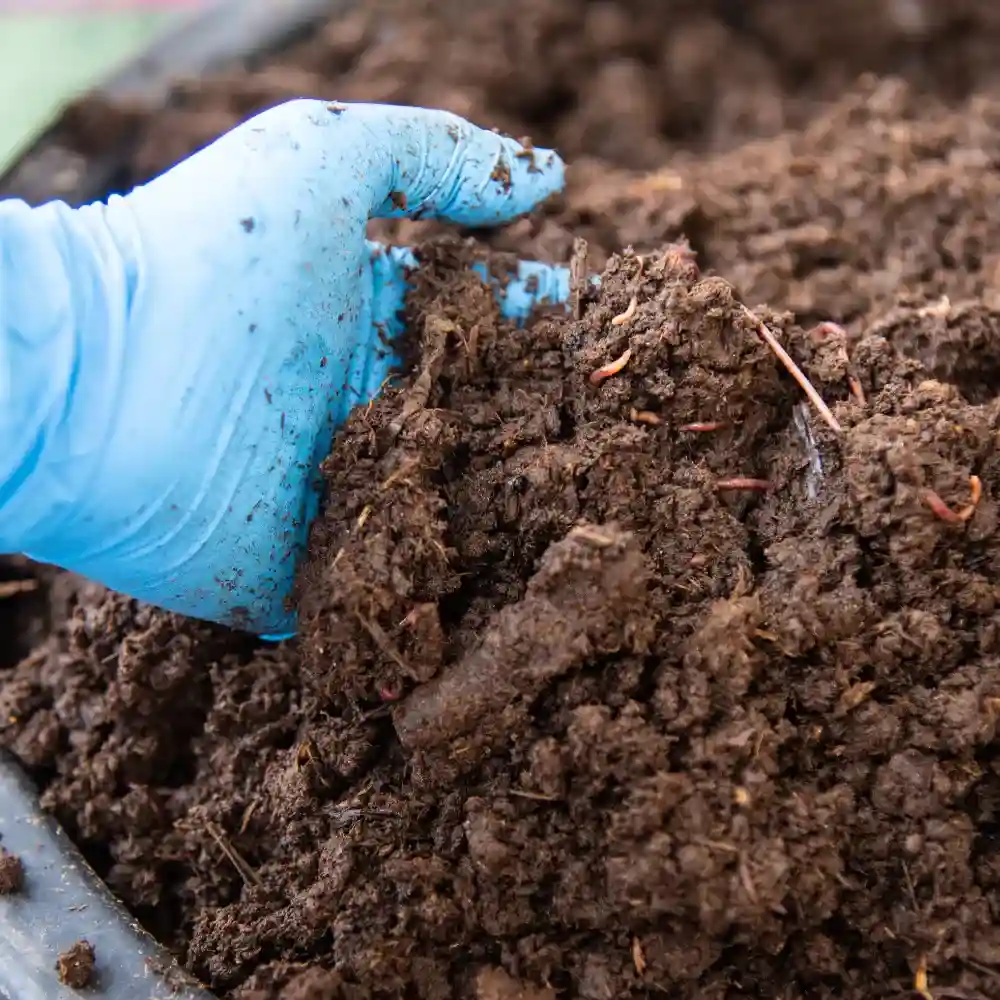
Adding used grounds to your worm farm can enhance worm activity, speeding up the composting process and leading to more nutrient-rich worm castings – a boon for your indoor plants. Just be careful not to add too much at once, as coffee grounds can heat up, potentially making your worm farm too hot.
Coffee Grounds as an Odor Neutralizer
Another notable use of grounds in indoor gardening is as an odor neutralizer. The grounds can absorb and eliminate unpleasant smells in your indoor gardening area or compost bin.
To use grounds as an odor neutralizer, simply place some dried grounds in a breathable fabric bag or an open container and put it in the area where you want to neutralize odors.
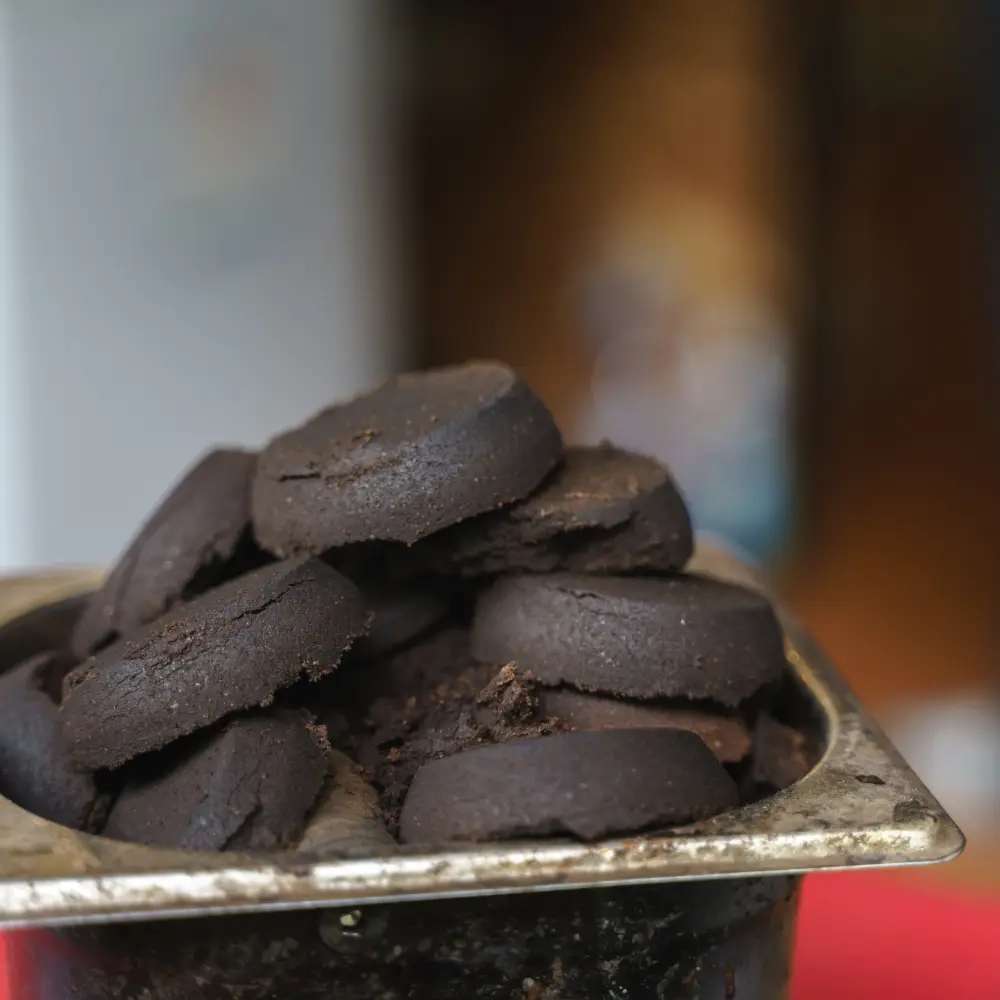
Whether it’s for composting, worm farming, or odor neutralizing, there are numerous ways to repurpose the grounds in your indoor gardening practices. These methods are not only beneficial for your plants but also promote sustainability by reusing coffee waste.
If you’re intrigued by the numerous benefits and applications of the grounds for indoor gardening and wish to learn more about other uses, make sure to check out our detailed article, “Uses for Used Coffee Grounds.”
Conclusion
In the wonderful world of indoor gardening, innovation is key, and the practice of using coffee grounds for plants indoors is an exemplary testament to that. This everyday kitchen waste has the potential to transform how we nourish and care for our plants, offering an array of benefits from enhanced growth to natural pest control.
Whether you’re wondering what indoor plants like coffee grounds or how to properly integrate the grounds into your plant care routine, understanding the advantages and application methods is critical. As we have learned, many indoor plants, including azaleas, hydrangeas, gardenias, and several lush foliage plants, appreciate the boost from the grounds.
But the usefulness of the grounds doesn’t end there. From composting and worm farming to odor neutralization, the grounds can greatly contribute to a more sustainable and effective indoor gardening practice.
As with all aspects of plant care, however, it’s important to pay attention to the needs of your specific plants and employ moderation. Overuse can lead to challenges just as much as deficiency can. Each plant is unique, and its care should be tailored to its individual needs.
Ultimately, the goal is to provide the best possible environment for your indoor plants to thrive. And as the success stories have shown us, the grounds can play a significant role in achieving that.
We hope that this guide has offered you valuable insights into the exciting potential of using coffee grounds for your indoor plants. May your plants flourish with this new addition to their care routine, and may your indoor garden continue to be a source of joy and pride. Happy planting!
FAQ
Can coffee grounds be harmful to indoor plants?
Yes, if overused or not properly prepared, the grounds can lead to soil compaction, over-acidity, and mold growth, which can be harmful to indoor plants.
How often should I add coffee grounds to my indoor plants?
Generally, it's advisable to apply the grounds once a month, but this can vary depending on the specific needs and tolerance of your plant.
What indoor plants like coffee grounds?
Indoor plants that appreciate coffee grounds include acid-loving varieties like azaleas and gardenias, and foliage plants such as Philodendrons and Monsteras.
Can I use coffee grounds for all types of indoor plants?
Not all plants will benefit from coffee grounds. Plants requiring well-draining soil and less moisture, like succulents, may not react favorably.
What are the benefits of using coffee grounds for composting?
Grounds enrich compost with nitrogen and other nutrients, promote faster decomposition of organic materials, and improve the overall quality of the compost.
How can coffee grounds help in controlling pests in indoor gardening?
Grounds can serve as a natural deterrent against certain pests like slugs and snails, and also help in controlling soil-borne pests such as fungus gnats.













